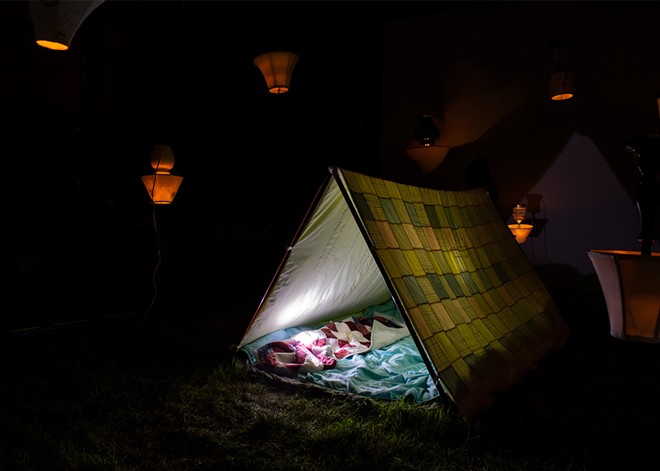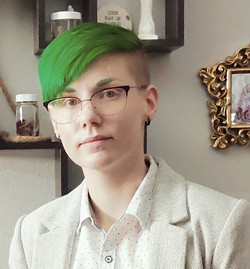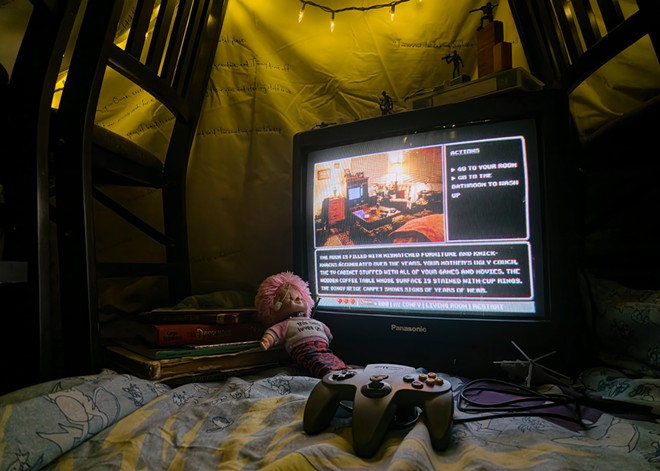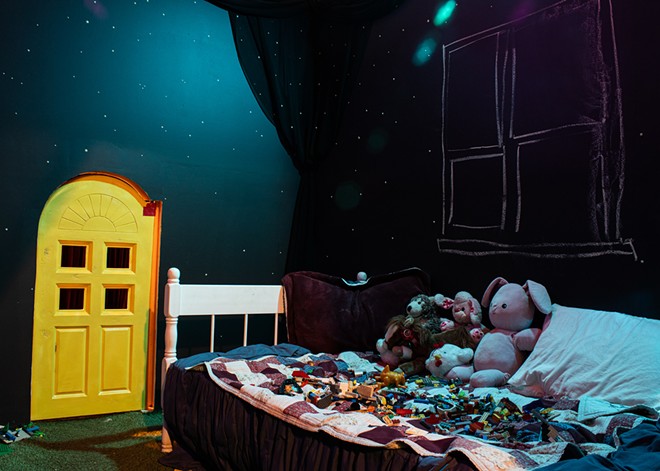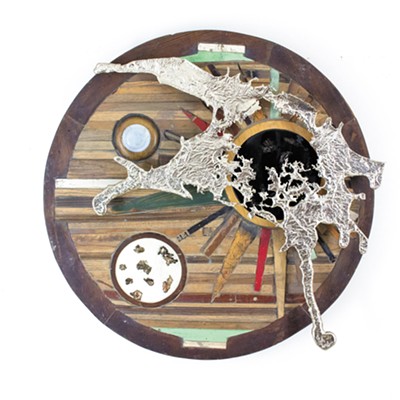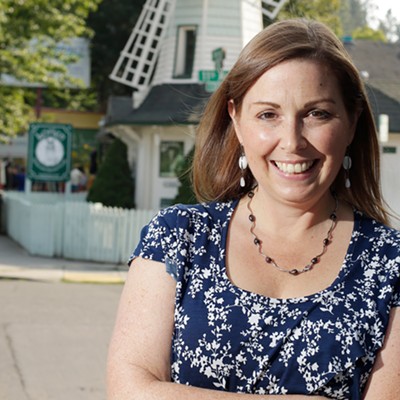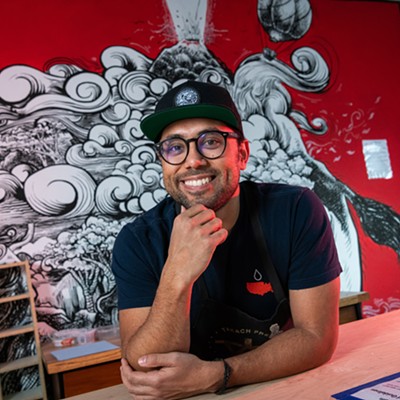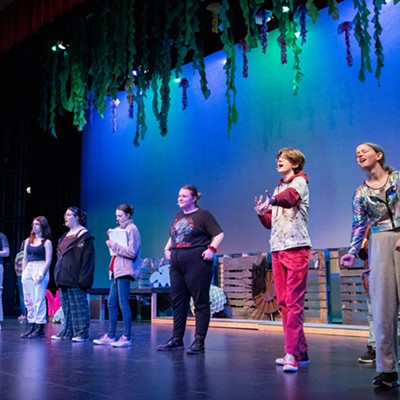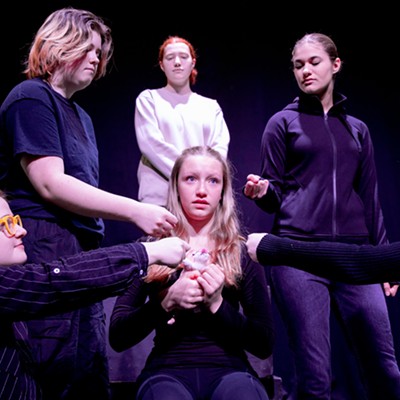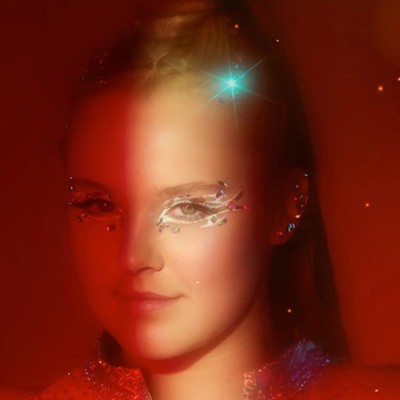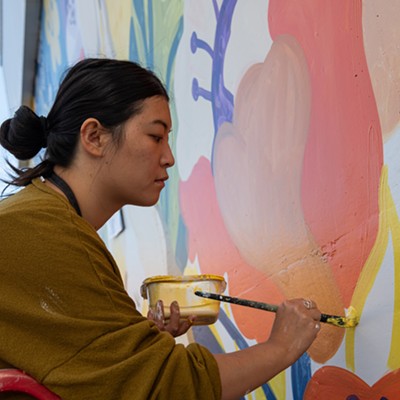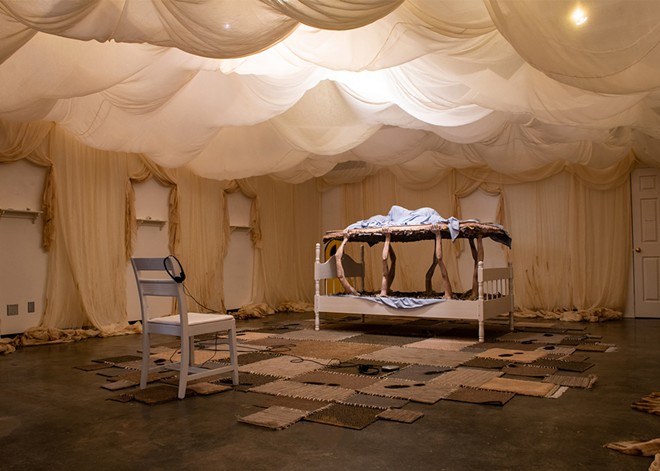
The word "lost" can suggest leaving a prescribed path, but also something taken away, as in lost youth. Conversely, loss can be purposeful — getting lost in one's imagination — or even positive, as in letting go. Fittingly, Quincey Miracle's new exhibition at Spokane Falls Community College, titled "It's Easy to Get Lost Here," is as open-ended as it is relatable by all.
Miracle revisits and re-represents adverse childhood experiences in their artwork as a way to "look back and trauma process a bit," as well as connect with the viewer. Rather than focus on sexual orientation, says Miracle, their work is a dialogue about "non-binary experience and ways to fulfill yourself or find self-actualization amid a very gendered society."
For the exhibition, which runs through Feb. 1, Miracle is transforming SFCC's gallery from floor to ceiling. Their installation art, as this artform is known, goes beyond making sculptural objects, instead incorporating and responding to the unique qualities of each physical space — floor, walls, ceiling, lighting, etc. — with the viewer experience in mind.
"I'm really interested in blending kind of the interior/exterior," Miracle says. "The shift between exterior and interior is really important when talking about non-binary identity because you have those very long-standing metaphors of the domestic — the interior being the feminine and the exterior being masculine."
To instigate that shift, Miracle is installing plush green carpet reminding of both the internal comforts of home and lush grass. The gallery space will be populated with kid-centric structures from a little treehouse to a blanket fort, again juxtaposing the notion of interior and exterior space.
"I'm pulling a lot of nostalgic items from the '80s, '90s, 2000s because the point of me making these forts is kind of exploring my identity and how that was formulated through adolescence and safe spaces and places that I found solace or understanding or connection in growing up and dealing with, you know, grade school, puberty, etc."
"It's equally hopeful as depressing," says Miracle, laughing.
Miracle grew up in Spokane, where their mother encouraged their artistic and performative bent.
"I always had all of these kinds of concurrent, nerdier interests," says Miracle, who was homeschooled. In addition to hanging out with kids in the drama club at Spokane's John R. Rogers High School, Miracle was heavily involved, starting in 2012, with Spokane's KuroNekoCon anime convention, including making props and costumes.
Miracle says they were into gymnastics as a child and had an interest in being in front of a crowd, although not on the theatrical stage.
"I wanted to make something between me and the audience there, something that was more real or maybe with more longevity," says Miracle, who currently teaches sculpture at the University at Buffalo.
SFCC's art program synthesized Miracle's varied interests into a cohesive way of working, while providing a path forward personally.
"I was always building and tinkering with stuff, but I didn't know that that could be art," says Miracle, who initially attended SFCC to pursue painting.
In former SFCC sculpture instructor Bernadette Vielbig's class, Miracle had an epiphany while doing an architectural assignment. Many students chose paint or fabric to finish their constructions, while Miracle recalls making a Frank Lloyd Wright-esque gingerbread house employing graham crackers and frosting.
"And it was just probably the most fun that I'd ever had making art, and then I wanted to do more," Miracle says.
In addition to the physical objects and spatial installations they create, Miracle also incorporates performance art, which might include scripted actions or spontaneous interactions with viewers.
"I could either be directly there and [the viewer] could feel my presence in the room, see my facial expressions, actually interact with me, or I could kind of, with much more heavy-handedness, put them through an experience ... that would get them to a certain head space," Miracle explains.
Miracle knows installation and especially performance art can be more challenging to connect with than, say, a painting. It might come across as boring, weird, or too artsy, they say, yet that discomfort primes the viewer for a more empathic interaction with the artwork and — by extension — the artist.
"They're already invested, they're already interested [in the art], and then they realize 'This is a lot more than I thought that it was,' and then ... they're invested in what I have to share," Miracle says.
"That might, I don't know, maybe change somebody's mind about their gay nephew," Miracle says, adding "maybe it'll just help them reflect on their own experiences."
Miracle's exhibition is fitting for SFCC in other ways, too.
"The art and artists selected for gallery programming reflect and support the student populations we serve and the artistic disciplines we teach," says SFCC gallery director Cozette Phillips. "Our aim is to promote learning, dialogue, and critical thinking, challenge inequities, and to enrich the cultural vitality of the campus and community."
"One of the themes of the college is to 'celebrate the future now,'" Phillips continues.
She developed the 2023-24 gallery programming to celebrate the "breadth and variety" of SFCC's Associates of Fine Arts graduates. The exhibition schedule was initially planned to coincide with the opening of the college's new and still unfinished Fine and Applied Arts Building, named Ssxetk (Ska-hét) in the Salish language.
Miracle, who graduated from SFCC in 2015, was the first artist slated to show work there. Instead, the exhibition and arts classes will continue to be held in the existing, 93-year-old Building 6 through winter quarter.
"The latest update that I have received is that we will have spring quarter classes in [the new building], with the first day of classes on April 1," Phillips says. ♦
It's Easy to Get Lost Here • Tue, Jan. 9-Thu, Feb. 1; open Mon-Fri from 8:30 am-3:30 pm • Free • SFCC Fine Arts Gallery, Bldg. 6 • 3410 W. Whistalks Way • spokanefalls.edu/gallery • 509-533-3710

